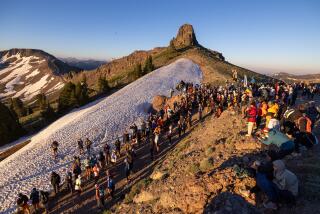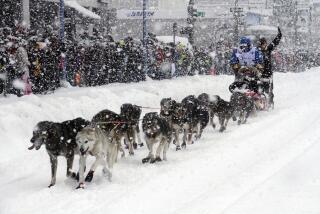Iditarod Praised for Moving Its Course North
- Share via
ANCHORAGE — When organizers of the Iditarod Trail Sled Dog Race decided to break with tradition and move the starting line hundreds of miles north this year, they say, it was largely out of concern for the dogs.
An extremely warm winter has ruined conditions at the historical site in Wasilla, just north of Anchorage. The March 1 ceremonial start is still set for Anchorage, thanks to trucked-in snow.
But the beginning of the actual race course is marred by glare ice, long stretches of open rivers and bare ground. Some sections through the Alaska Range are impassable.
“No one wants to jeopardize the safety of the dogs,” said Stuart Nelson, chief race veterinarian. “One of our greatest fears is dogs breaking through the ice or drowning. The point is to move the race where it’s safer.”
The course alteration is unprecedented. But also unprecedented is the praise that the change has drawn from the Humane Society of the United States, a consistent critic of the 1,100-mile race to Nome. The Washington, D.C.-based organization is among animal welfare groups that annually berate the race as exploitation for the sake of entertainment.
“It’s great -- anything they can do to make sure the animals are safer,” said Brian Sodergren, group spokesman. “We’re glad they’re taking the dogs into consideration.”
The Humane Society continues to monitor the race but has backed off in recent years from actively campaigning against it, recognizing a reduction of dog deaths and injuries.
The group commends race organizers for heeding public scrutiny and implementing reforms resulting in improved dog care. But it isn’t about to endorse the Iditarod any time soon.
Sodergren said the organization has counted at least 118 dog deaths since the race began in 1973. And although fatalities have declined from Iditarod’s earlier years, dogs are still dying at a rate of one or two each year.
“More work needs to be done if you’re still seeing the death and injury of dogs year after year,” Sodergren said. “We’re concerned about the extreme competitive nature that’s brought in -- especially in the Iditarod -- with people trying to break time records. We’re also concerned about the extreme length of the race. We’re concerned when animal welfare issues are put in the background.”
It’s an argument that Iditarod organizers face every year from critics who believe the dogs are forced to run for hours through treacherous terrain with little rest, and are sometimes literally run to death.
People for the Ethical Treatment of Animals, a Virginia-based animal rights group, is launching its annual letter-writing campaign to persuade Iditarod sponsors to withdraw their support. The group remains unconvinced that the race is becoming any more animal-friendly.
“It is highly questionable that the fact that the race is being moved has anything to do with the welfare of the dogs,” said PETA spokeswoman Amy Rhodes. “The move is simply to ensure that the race goes on, not that animals are not injured or killed.”
Nelson, the chief veterinarian, said an intricate system of checks and balances has evolved over the years to monitor some 1,000 dogs along the trail.
Nelson works with 35 volunteer veterinarians who evaluate every dog at each checkpoint. Pre-race checks are also done, and mushers must take health measures such as deworming their animals and keeping dog-care journals during the race.
Rest stops are mandatory. Drug testing is done randomly throughout the race and for the top 20 teams in Nome to guard against abuse of performance-enhancing drugs -- including aspirin.
Thorough physical exams are performed on dogs dropped from the race, Nelson said. When an animal dies, necropsies are performed.
Iditarod officials have aggressively pursued medical research that has led to improved dog care, Nelson said. Recent studies have focused on gastric ulcers, an underlying cause of some deaths, including the death last year of a dog belonging to Willow musher DeeDee Jonrowe, an Iditarod veteran. A dog belonging to Cincinnati musher Jim Oehlschlaeger also died in the 2002 race when it became tangled in a gang line.
Rhodes dismisses the argument that the dogs are well-honed athletes that live to run, showing their eagerness at the starting line by straining against their harnesses or pawing the air.
“That’s not to say they know what they’ll be up against in the next 1,100 miles,” Rhodes said. “These animals are forced to participate in something they obviously don’t have a choice in.”
But Nick Vukich, a Green Bay, Wis., veterinarian and Iditarod volunteer since 1995, said the dogs do have a choice.
“Husky breeds are pretty much free spirits,” Vukich said. “They’re not going to do anything they don’t want to do.”
Jonrowe, regularly a Top 10 finisher, can ruefully attest to that.
In 1999, she scratched when her dogs revolted in subzero winds and parked themselves on the frozen Yukon River, refusing to budge. A decade earlier, her team quit four miles from Nome.
“I had to wait until it got dark and I could see the lights of Nome,” Jonrowe said. “Then I ran ahead and my dogs followed me.”
The Iditarod commemorates the desperate run by sled-dog teams to deliver diphtheria serum to Nome during an epidemic in 1925. Teams of 12 to 16 dogs and their mushers run the course, usually in nine to 12 days.
After the ceremonial start in Anchorage on March 1, the actual Iditarod racing begins March 3 in Fairbanks. The revised route will run for 437 miles to Ophir, where it will rejoin the traditional Iditarod trail. The total revised route will be longer than the traditional Iditarod, totaling about 1,200 miles.
More to Read
Sign up for Essential California
The most important California stories and recommendations in your inbox every morning.
You may occasionally receive promotional content from the Los Angeles Times.













